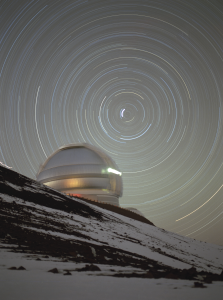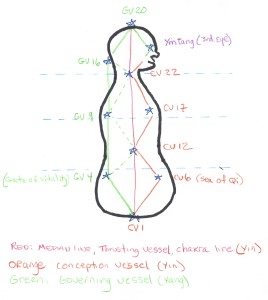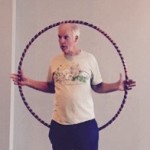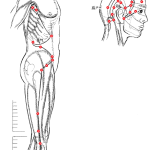 Boston Workshop Notes: October, 2017
Boston Workshop Notes: October, 2017
Part 1
When the Tao’ists of old contemplated the night sky, they noticed the way the stars rotated around the north star, especially the constellations Ursa Major (the big dipper) and Casseopeia ( the mythological Greek queen on her throne. They noticed that this macro-cosmic orbit and its repeating cycles were replicated on the earth as lunar and seasonal cycles of weather and the movements of water, wind, soil (annual flooding, bringing fresh topsoil to the deltas) and heat. When they turned their attention inward, they discovered the human body also has cycles and rhythms (as above, so below). The mapping of what is now called the microcosmic or small orbit awakened links to both physiological and emotional health as well as spiritual awakening.
We can use this the mapping of the human energy field in our explorations of embodied wisdom through yoga/asana practice. Yoga begins by refining the capacity to pay attention. In his commentary to Patanjali’s very first sutra, I.1, Vyasa states “yoga is samadhi”; that “samadhi is a natural attribute of the mind-field or chitta”; but not when the mind-field is disturbed, dull or distracted. Only when the mind field is “ekagra” ( one pointed,) or dissolved in stillness is it said to be yoga. The mental alchemy is the transforming the disturbed, dull and distracted mind states to ones of mindful attention, focused attention and dissolved in stillness.
6 Possible Qualities of Attention:
Disturbed, Dull, Distracted, Openly Attentive (Mindfulness), Focused Attentive (Dharana/Dhyana/Samadhi), Dissolved in Stillness/Emptiness/Awareness/Drashtuh Svarupe
Open Attention in Action:
Every moment we are engaged in the world around us is an invitation to mindful attention. Driving a car, having a one on one conversation, being in a group environment such as work, shopping or school; these are opportunities to discover the ‘relational fields’ of overlapping energy where our wounded-ness and creativity can both awaken from a place of love, compassion and wisdom. Here, we meet the world as it is, as it arises moment to moment and the ‘inner and outer’, or, the subjective and objective realms of reality can find integration and the realization of wholeness. Staying present does not mean ignoring past and future, but recognizing they are also arising now. Then we don’t ‘get lost’ or forget, through disturbance, dullness or distraction.
Directions of Focused Attention:
Yoga begins when the mind-field is not just brought to the present moment, but can stay there effortlessly. (Otherwise it is distracted.) The complement to mindful attention, a more global state of awareness, is focal attention or dharana/samadhi. Here attention tunes out everything but a very specific information stream or mental process. It may be an algebra problem in your homework. Or a thesis for a paper. Mediation begins with bringing attention to the breathing process. Us somanauts use the ongoing stream of sensations and perceptions coming form the body to both refine attention and also deepen the capacity to feel and know what is happening. What are some of the ‘seeds’ of attention that can help you cultivate one-point awareness?
Outer objective reality: What is happening around you, locally, globally, cosmically? The present moment offers many possibilities, but also many distractions. You need discipline and passion to keep your focus.
Inner subjective reality: Our thought patterns, emotions, prana/qi flow, dreams, and imagination are all possible entry points to cultivate a refined focal attention.
Subjectivity itself: A little more advanced, but Awareness, or any and all words that point to this, such as: Emptiness, Stillness, Silence, Buddha Nature, etc. Attention dissolves into Pure Awareness with no object of attention.
Four Dimensions of Spatial Consciousness
When we use our embodied energy field, as in asana, to harness attention, we have some delightful geometric possibilities to explore. As asana explores our spatial dimension very deeply, we can use geometry 101 as guide. Geometry describes 4 basic spatial dimensions, and we can call ‘Time’ as the 5th
Zero Dimensional: a point, bhindu, ekagra citta, acupuncture ‘cavity’. A point has no length, no height, and no depth. Thus 0 dimensions. It is a highly concentrated state.
One Dimensional: link two points to get a line. It can be straight or curved (arc), bound or unbound. It has length, but no width or depth.
Two Dimensional: close the lines to form surface area: geometrical, ie circle, triangle etc, or irregular. Length and width, no depth.
Three Dimensional: volume: spheres, cubes, pyramids, and many other options: length, width and depth.
Four Dimensional: all of the above, moving and changing in time
Focused Attention on Prana/Qi flow with Microcosmic Orbit (General Principles):
 Bringing attention and staying on key points, using imagination to assist with sensation/perception
Bringing attention and staying on key points, using imagination to assist with sensation/perception
Linking the points in small arcs/lines through root and/or crown chakras
Bringing attention to the 2 dimensional field dynamics of circles, especially the microcosmic orbit.
Bringing attention and staying on flow through the volume, using the center axis.
Monitoring subjective experience
Resting in Pure Subjectivity (drashtuh svarupe)
Specific Practices While Sitting:
Breathing into the lower dan tien, the lower diamond in the diagram above. Feel the volume of the pelvis up to just below the navel and fill with breath. Feel the pelvic bones moving with the breath like the ribs do. Abdominal breathing (yin/yin, soothing, quieting the  mind): fill on in breath, empty on out breath. Reverse abdominal breathing (yang/yin, energizing, activating): empty on in breath, fill on out breath. Explore how different these two are and learn how to apply them in your daily life. Begin and end all Microcosmic orbit practices in the lower da tien. It awakens the cooling yin water element, grounds the energy into Mother Earth, quiets the mind and builds a strong energetic foundation for your life activities.
mind): fill on in breath, empty on out breath. Reverse abdominal breathing (yang/yin, energizing, activating): empty on in breath, fill on out breath. Explore how different these two are and learn how to apply them in your daily life. Begin and end all Microcosmic orbit practices in the lower da tien. It awakens the cooling yin water element, grounds the energy into Mother Earth, quiets the mind and builds a strong energetic foundation for your life activities.
Refining the points and arcs of the lower dan tien: While sitting, bring your attention to the CV-1 point in the very center of the perineum. Inhale and exhale through this point, feeling it becoming elastic. Stabilize your attention here. Very tiny micro-movements of the sitting bones back and forth can help you find the center. This is the meeting point of all the yin vessels and a key place in the body to awaken.
Then, find CV-6, on the front body, below your navel. Visualize it out in space as well, like on the hula hoop seen below. This will help activate the whole energy field and help the body stay relaxed. Now, inhale into CV-1 and then imagine the exhalation traveling in an arc up to CV-6. Inhale into CV-6, imagine the exhalation traveling in an arc back to CV-1. Or Inhale from CV-1 to CV-6, exhale return. Or inhale from CV-6 to CV-1, exhale return. Then stay with CV-6, inhaling and exhaling for several breaths until you can find and stay with the point. In actuality, you may find yourself in CV-5 or CV-4, which may be easier to feel, for you, but feeling the arc and the end points is all that counts.
Repeat the above practice, this time going from CV-1 to GV-4 at the back body, exploring one point at a time, traveling back and forth, etc.
Repeat the practice connecting the four points of the thrusting vessel (Chong Mai) as shown above, CV-1, CV-12, CV-22 and GV-20, tracking up and down. This is the chakra line, or mid-line of the body and traces its origin, along with the Conception vessel (Ren Mai) and Governing Vessel (Du Mai), to the earliest moments in embryological development. Pause at each point for several breaths so it becomes familiar and easier to find. Remember, an acupuncture ‘point’ is actually a ‘cavity or cave’, meaning the action takes place in empty space, both outside and inside the body.
Four Point Breathing: Connect CV-1, CV-6, CV-12 and GV-4 in a square or diamond shape. In Tao’ism, 4 is implies a whole cycle, such as the annual (four seasons,) or daily (midnight, sunrise, noon and sunset.) Or connect CV-1, CV-17, GV-20 and GV-9, (root, crown and heart). Be creative.
Specific Practices While Standing:
Once we are on our feet, we want to integrate the limbs with our Micr-cosmic orbit. (Ideally the limbs are engaged while sitting, but it is easier to find them standing.) In tasasana, find the K-1 points on the soles of the feet and engage them. Kidneys are the most yin of the yin organs, governing the water element, so feel them linking to CV-1, the seat of the yin and feel the support coming into the pelvic floor, and the whole micro-cosmic orbit.
Finding Planes (two dimensions): Using the support of the legs, feel the micro-cosmic orbit as a surface bisecting the body into right and left. Fill in the space inside the circle with attention/energy/light/qi, and let your body feel a part of the disc. Soften the tissue and let it respond. In this plane, try bending forward slowly and returning, tadasana-uttanasana-tadasana and feel how the body responds. Does it contract along the yang/back or collapse along the yin/front? Beginners collapse the front. Intermediate students contract the back to prevent the collapse of the front. Use the field of energy created by the plane/energy disc to keep both the front and back body open and vibrant (sattvic). Minimize, as best possible, or course, the collapsing/tamasic and contracting/rajasic habits.
Using the information coming from any of your favorite poses, create your own personal map of the micro-cosmic orbit. Mine has some major gaps. If I use a clock as an image, with GV-20 at 12 and CV-1 at 6, 1 – 5 at the back, 7 – 11 at the front, I have pie shaped blockages between 2 and 3 and 10 and 11 in my energy field, and in the flesh. I try to open them up, and back they go into dullness and confusion. It’s a process.
with GV-20 at 12 and CV-1 at 6, 1 – 5 at the back, 7 – 11 at the front, I have pie shaped blockages between 2 and 3 and 10 and 11 in my energy field, and in the flesh. I try to open them up, and back they go into dullness and confusion. It’s a process.
Correct action will bring up places where your energy field is blocked. the challenge is to meet these with patience, wisdom, lightness, and with what Pema Chodron calls ‘discomfort resilience’. Awakening is not about eliminating problems, but seeing them as opportunities to deepen your compassion and wisdom.
Another way to work with clock is to take points opposite each other and work with them simultaneously. 12 and 6 give us crown and root chakras, or GV-20 and CV-1. Feel the yang energy pushing them away from each other while the yin energy is pulling them together. If I rotate the whole circle 2 hours, I can create a similar polarity with CV-17 and GV-4, or GV-9 and CV-6. This links front and back, upper and lower, yin and yang. You can also be the minute hand moving in a circle through the points. Explore both clockwise and counterclockwise directions. Make up your own ways to play with this.
 Lateral Plane: If we rotate the orbit (clock) 90 degrees we find ourselves in the lateral plane. Crown and root chakras, GV-20 and CV-1 still involved, but we are no longer on the micro-cosmic orbit. Here we can activate points on the Gall Bladder Meridian on the side body with our fish body poses like trikonasana and ardha chandrasana.
Lateral Plane: If we rotate the orbit (clock) 90 degrees we find ourselves in the lateral plane. Crown and root chakras, GV-20 and CV-1 still involved, but we are no longer on the micro-cosmic orbit. Here we can activate points on the Gall Bladder Meridian on the side body with our fish body poses like trikonasana and ardha chandrasana.
According to Daniel Keown in ‘the Spark in the Machine, the gall bladder is the organ that governs the lymphatic system, a key aspect of the fluid body.
gall bladder is the organ that governs the lymphatic system, a key aspect of the fluid body.
In part two of this post, we will see how the gall bladder points can also be used to give us our sense of volume when we add the girdle or belt vessel (dai mai) and offer some insight on how these ‘vessels’ relate to the organs and meridians. In part three, we will look at how all of this fits into the Tao’st view of spiritual evolution.
Remember:
The tao that can be told
is not the eternal Tao
The name that can be named
is not the eternal Name.
The unnamable is the eternally real.
Naming is the origin
of all particular things.
Free from desire, you realize the mystery.
Caught in desire, you see only the manifestations.
Yet mystery and manifestations
arise from the same source.
This source is called darkness.
Darkness within darkness.
The gateway to all understanding.
(Chapter 1, Tao te Ching, by Lao T’zu, translated by Stephen Mitchell)


